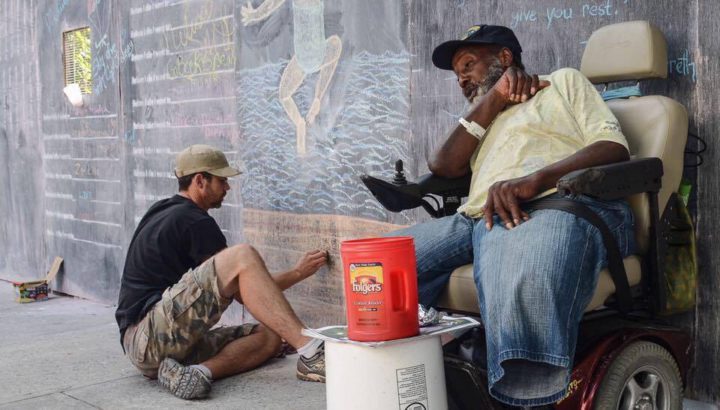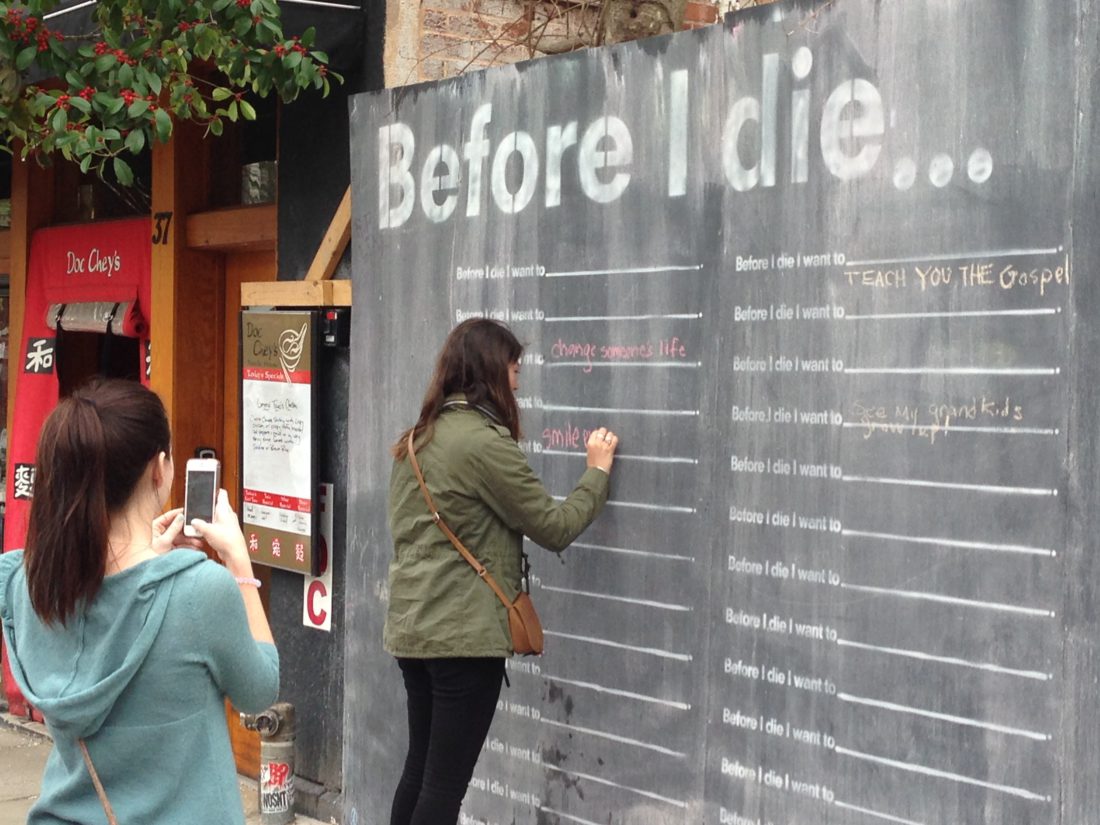“Nothing lives long — only the earth and the mountains.”
— Cheyenne death song
Death isn’t generally something people take lightly, but the “Before I Die” wall on Biltmore Avenue gave tourists and locals alike a fun place to ponder their own mortality. The concept was simple: Pick a piece of colored chalk from the little plastic tray and scribble your dreams, ambitions or, sometimes, jokes on the wall for all of Asheville to read.
“To me, it was a fixture of the Asheville landscape,” says Asheville resident Maggie Rainwater. “It was one of the first things I noticed when walking around town. It seemed like a gathering place for people.”
Tucked between the now closed Doc Chey’s Noodle House and Bender Gallery, the wall quickly became a beloved Biltmore Avenue attraction. Throngs of folks would line up on hot summer days to share their philosophical thoughts, take photos and reflect on the countless musings that covered every square inch of space.
“All of my friends who would visit, I’d tell them to go there,” remembers resident TJ Bell.
But since the second week of April, the ever-changing array of multicolored messages and doodles no longer grace the plywood barrier. Instead, a solid expanse of forest green paint now covers the chalk-friendly paint and stenciled fill-in-the-blank lines that said “Before I die I want to… .” And as if that weren’t enough, the teaser prompts that once encouraged passersby to join the fun have been replaced by signs asking would-be writers to share their thoughts elsewhere.
Pete Libert, who works at the neighboring Manicomio Pizza, says the loss of such a seemingly integral part of Biltmore Avenue has taken many people by surprise.
”One lady came in and asked about it yesterday. She was looking for it specifically, and I sent her down there not knowing they’d painted over it,” says Libert. “I walked by it every day, and I liked to look and see what people wrote. I can’t do that anymore.”
To die for
New Orleans-based artist Candy Chang came up with the idea after losing a loved one. According to her website, she wanted to encourage people to think about their relationship with death. With permission from the owner, she created the original wall on an abandoned house in her neighborhood.
But the public response surpassed all expectations, and the project soon exploded into a worldwide phenomenon. Since its inception, more than 4,000 walls have been erected in 78 countries and 35 different languages, the website reports.
Third Messenger, a local group whose focus is death-related activism and education, brought the Before I Die movement to Asheville in the summer of 2014. Saïd Osio, the group’s co-director, says he wanted participants to connect with their feelings about death and dying in a positive and constructive fashion.
“I’ve been working in the end-of-life field, and it kind of propelled me into looking at it as an activist,” Osio explains. “I was looking at it as overcoming death-phobic culture by having people engage in that conversation.”
Karen Ramshaw of Public Interest Projects, which co-owns and manages 37 Biltmore Ave., says that she and the other owners loved the idea of hosting the interactive art piece on the plain wooden fence that borders the vacant lot.
The idea, she recalls, “was not just that people would write on it but that it would spark conversation, that people would stand in front of the wall and read what other people had written and think about it for themselves.”
A shared mission
Like other Before I Die walls around the world, the Asheville project was originally supposed to run for six months, notes Osio, but support from Ramshaw and the community kept it alive.
The property owners, he says, “were going to try to pull the plug a long time ago, and [Ramshaw] came to our rescue and championed it.”
As the wall stood in limbo month after month, Asheville resident Earl Lee Gray, a disabled veteran better known as Happy, stepped up as the unofficial caretaker. Gray regularly sat in front of it, and with Osio’s blessing he began handing out chalk and cleaning the wall daily.
“That allowed it to keep going,” says Osio. “At that point we kind of disengaged from the wall and let Happy take care of it.” Keeping the wall cleaned off was a challenge, he says, “So when he wanted to take it over, we said, ‘Go for it.’”
Joshua Martin is among the many downtown visitors, workers and residents who took an interest in the project, and eventually, he decided to help Happy with the maintenance. “We connected and had a friendship; he was very inspiring to me,” says Martin. “He was in a wheelchair and could only wash the bottom half of it, so for a long time I was doing the top half.”
The shared labor brought the two men closer together, contemplating and laughing at the various

responses as they worked.
“I would always read every single one before I washed it off,” says Martin. “Both Happy and I considered it part of the whole ritual — sort of washing them off and sending them out into the universe to possibly come true. It always felt like part of the process: the exercise and the impermanence of the art and the chalk and life, and this whole concept of seizing the day and manifesting what you want in life now, before you die.”
Changing of the guard
After years of declining health, Happy passed away in October 2016. Friends, neighbors and passersby celebrated his life in the best way they knew: by adorning the wall with chalk-written messages, flowers, cards and candles for weeks after his death.
“He was definitely a stabilizing force there. There was a lot of love for him in the community,” notes Martin.
That love coalesced, he says, into an impromptu group that was determined to keep the project going. With no formal organization or planning, says Martin, the supporters found opportunities — on lunch breaks, while walking to work or strolling home — to stop off and clean the wall or provide fresh chalk.
Despite those noble intentions, however, the little group of caretakers eventually unraveled.
“They had lives,” says Ramshaw. “This was just something they were doing as volunteers. They weren’t getting paid or anything, and nobody else in the community stepped up.”
Art project or eyesore?
As the weeks and months rolled by, the accumulating layers of chalk rendered the colorful art and inspiring words illegible, and the wall fell victim to frequent tagging and vandalism. Used needles began to litter the ground. Gradually, neighboring residents and business owners began to see the wall more as an eyesore than an art project.
“‘Before I Die’ was great; it just couldn’t get the maintenance it needed, and we don’t have the police presence on Biltmore Avenue to deter a lot of bad activity,” says Neal Reed, who’s managed the nearby Fine Arts Theatre for 18 years. “There was always a lot of really vulgar stuff on the wall, so who was going to police that? We don’t have the time.”
“I liked it originally when it first came and when Happy would clean it,” says Jeff Lazzaro, whose Double D’s Coffee & Desserts bus sits just a few doors down. “Now that he’s gone, it’s been an issue.”
With nowhere else to turn, Ramshaw reached out to the city for help. She says Public Interest Projects offered to pay to renovate the fence and add a fresh coat of chalk paint if the city agreed to take responsibility for cleaning and monitoring it, but the city refused.
“Karen had been in touch with us about the wall over the past few years, as had the Asheville Downtown Association,” says Downtown Development Specialist Dana Frankel. “City staff looked into relocating the wall back in 2017 when there was a possibility of it being removed.” Those plans didn’t move forward, she continues, “since maintenance would still be the major challenge.” Frankel expresses gratitude for the company’s willingness to manage the feature on behalf of the community as long as it did.
Finally, feeling worn out by the responsibility and sensitive to neighboring business owners’ concerns, Ramshaw decided it was time to let the project go.
“For a while, we really tried to keep it clean, but it was a losing battle,” she recalls. “I said, ‘You know what? We just can’t do this anymore.’ It’s just not fair to the people on the street.”
All about impermanence
Since the wall was painted over, Ramshaw says her office has received emails and phone calls from folks who miss the artwork or simply wonder why it disappeared. For her, taking down the wall was bittersweet.
“It started off as a really good space. There’s part of me that hated losing it, because it should have been a really great thing, but people get it,” Ramshaw says now. “I just feel like we don’t create a lot of opportunities to have meaningful conversations. The way the wall ended up, it wasn’t really about conversation.”
For Osio, the wall’s demise underscores one of the project’s central messages: learning to let go.
“We never intended to keep it going forever. I feel good about it because it’s a living tribute to an idea: Before I Die is all about impermanence. That’s why we used chalk — an impermanent instrument,” he explains.
Martin agrees. “Everything that was ever written up there was washed off: Nothing lasts forever,” he points out. “I’m hopeful that maybe the energy of it and the concept of interactive public art will come forward again in another project that we can all support. I’m feeling a little bit sad but more grateful for the chance to have been part of that.”




Before you comment
The comments section is here to provide a platform for civil dialogue on the issues we face together as a local community. Xpress is committed to offering this platform for all voices, but when the tone of the discussion gets nasty or strays off topic, we believe many people choose not to participate. Xpress editors are determined to moderate comments to ensure a constructive interchange is maintained. All comments judged not to be in keeping with the spirit of civil discourse will be removed and repeat violators will be banned. See here for our terms of service. Thank you for being part of this effort to promote respectful discussion.